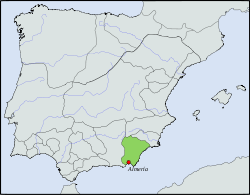Taifa of Almería
| Taifa Kingdom of Almería | ||||||||||
| طائفة المرية Reino Taifa de Almería | ||||||||||
| ||||||||||
 Taifa Kingdom of Almería, c. 1037. | ||||||||||
| Capital | Almería | |||||||||
| Languages | Arabic, Mozarabic, Hebrew | |||||||||
| Religion | Islam, Roman Catholicism, Judaism | |||||||||
| Government | Monarchy | |||||||||
| Historical era | Middle Ages | |||||||||
| • | Downfall of Caliphate of Cordoba | 1010 | ||||||||
| • | To Valencia | 1038–1042 | ||||||||
| • | To the Almoravids | 1091–1140 | ||||||||
| • | Annexed by Castile | 1147 | ||||||||
| Currency | Dirham and Dinar | |||||||||
| ||||||||||
The Taifa of Almería (Arabic: طائفة المرية, Ta'ifa Almería) was a Muslim medieval kingdom in what is now the province of Almería in Spain. The kingdom originated in 1012 and lasted until 1091.
In this period the city of Almería reached its historical splendour under powerful local emirs like Jayran or Jairan, the first fully independent Emir of Almería and Cartagena, and Abu Yahyà Muhammad ben Ma'n.
Almería declared independence of its province from Caliphate of Cordoba around 1012. It remained as an independent kingdom, although several campaigns of the Taifa of Seville diminished its territory in the North.
The kingdom was important due to its strategic location, its harbour, and a developed a very important textile industry, with around five thousand looms, being also a center of silk industry, which originated a very strong commerce with other parts of Europe and which remained until the Muslims and Jews were expelled in the 17th century. As the emirs of Granada, Seville and Valencia tried to conquer the little kingdom, Almería suffered many sieges, but remained independent until the arrival of the Almoravids, except for a short period of Valencian occupation, after which the governor sent by the Valencian King Ma'n declared again the independence of Almería.
The kingdom finally was annexed to the Almoravid empire as all the other Taifas.
List of kings
Slavic rulers
- 1012 Aftah.
- 1014 Jayran. Slavic slave from Cordoba Caliph palace, who dedicated his rule to the development of Almería.
- 1028 Zuhayr, also a former Slavic slave from Cordoba
- 1038 Abu Bakr al-Ramimi
- 1038 Abd al-Aziz al-Mansur, al-Mansur's grandson, King of Valencia
From 1038 to 1041 Almería belonged to the taifa of Valencia.
Banu Sumadih family
- 1041 Ma'n ben Muhammad ben Sumadih tuchibí
- 1051 Abu Yahyà Muhammad ben Ma'n, al-Mutasim
- Regency period of Abu 'Utba from 1052 to 1054 or 1055
- 1091 Ahmad ben Muhammad, Muizz al-dawla (only from June to October or November 1091)
Symbols
The first historically known flag of Andalusia, and one of the first flags in Europe, was the taifa of Almeria flag, which was fully green except of a white strip in its middle. This flag gave birth to the green and white flag used for many other kingdoms in Southern Iberia, like the Kingdom of Granada which had a red flag as main one, but also kept many different green and white flags for the different locations of the kingdom. It is said that after the defeat of Granada, twenty flags were conquered, eighteen of which were green and white stripped. It remained also as the flag of the Castilian troops in the Andalucia region, and in the 19th century was adopted as the official flag for Andalucia and its autonomist movement.
When Abu Asbag Ibn Arqam, a poet from Guadix in actual Granada, vizier of King Almotacin of Almería, saw the green and white flag on top of the Castle Alcazaba, wrote a poem which is regarded as the oldest written document describing a flag in Europe:
a green flag
wears a belt she's made with the white dawn
spreads over thou a delightful wing,
let her ensure your happiness,
when she grants thou a triumphant soul.